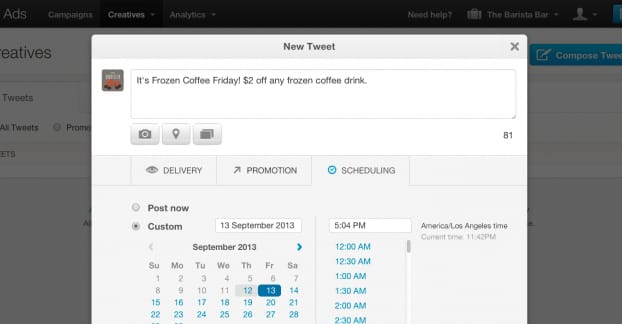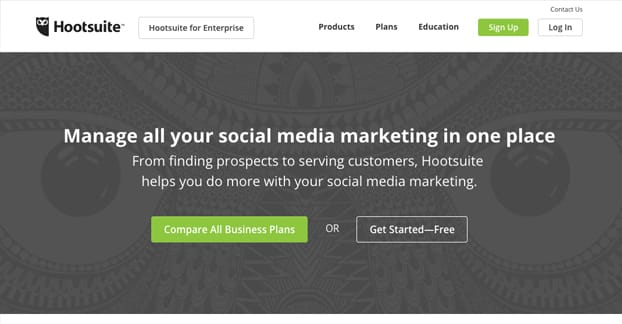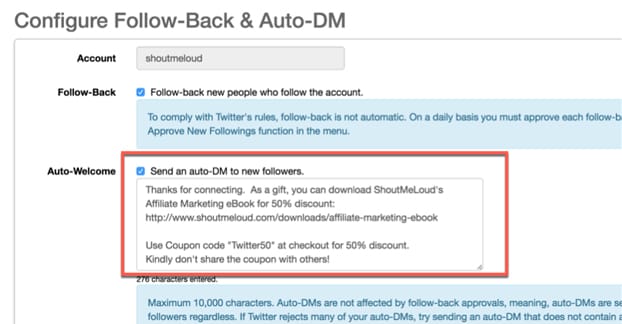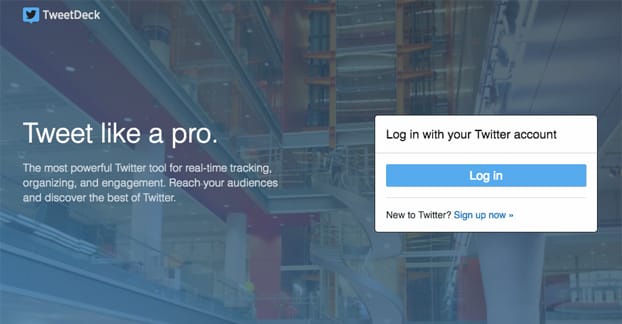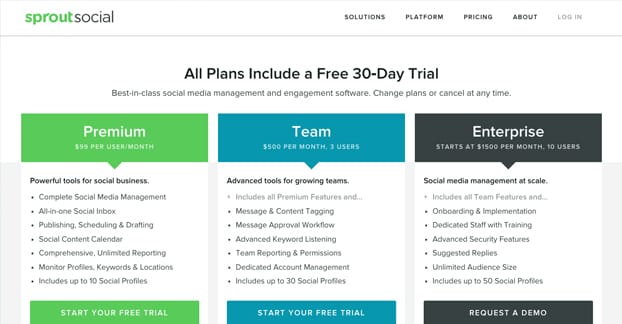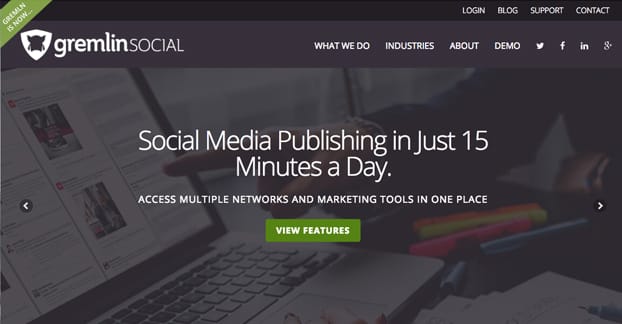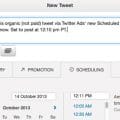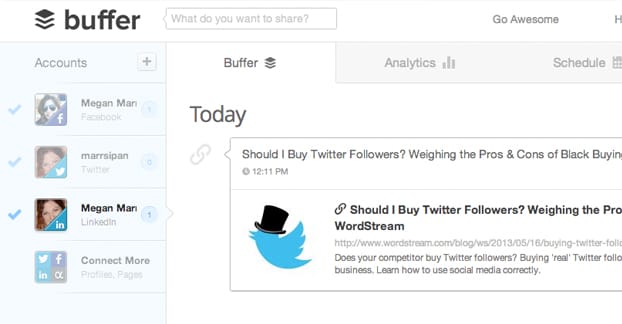There are a million and one tools out there for managing a Twitter account. There are two things almost all of them seem to have; analytics and scheduling. This is no mistake, either. Twitter’s API has a lot of different features developers can use, but most of them require some level of skill and inventiveness to really make use of. Scheduling, however, is trivially easy to implement, and analytics just need a graphical skin over what Twitter already provides to business accounts and verified accounts.
With so many options for scheduling available, I thought I’d take a look at a bunch of them and see which one of them comes out as the best. Let’s take a look, shall we?
Hootsuite
Hootsuite is number one on this list because it’s probably going to be number one for most people reading this post. However, I won’t say it’s number one without a doubt, because it has a few drawbacks.
First of all, we have the free version of Hootsuite. The free plan allows you to manage up to three social media accounts on one dashboard. This could be three Twitter accounts, a Twitter, Facebook, and Pinterest account, or whatever combination you want from among the networks they support. Here is one drawback: if all you need is scheduling for one Twitter account, you don’t need to add more than one, and this feature is unnecessary.
As with most Twitter apps, Hootsuite’s free version offers basic analytics and content scheduling options. Their scheduling can be set manually, or it can be set to pick an optimal time within your content calendar and with the activity levels of your users.
Other features include some content suggestions, content Hootsuite automatically locates as coming from influencers and as being in your niche. You can click to schedule them or you can ignore them at your whim. The app also includes lead capture sweepstakes and contest features. You can hook up to two RSS feeds to automatically share on Twitter and other social networks as well.
Hootsuite is also extensible using a variety of apps. The Hootsuite app store is fairly large, with over 150 apps available, to do anything from integrate with Mailchimp to building custom forms. Some are free – 134 at current count – but others require a payment, often monthly, around $5.
Hootsuite’s free version is great for small businesses trying to manage two or three social profiles, but if you need more features, you’ll need to invest in paid versions of the app. The $10 monthly version adds in seven more social profiles for a total of ten, gives real time analytics, removes the limit on content suggestions and on RSS integrations. The next step up, at $35 per month, allows up to five team members, doubles the social profiles, gives you custom analytics views and gives you bulk scheduling.
This right here is important, because some brands rely on bulk scheduling, and that is only available in the middle tiers of paid plans from Hootsuite. To continue, this plan also includes campaign templates, a custom URL for links, and training.
Other plans scale up from here. Figure that they add more social profiles, more features for analytics and apps, and more training. If you’re looking for something with so many advanced features, you’re probably not reading this article, to be honest. You can check the advanced features on Hootsuite’s plans page.
Overall, Hootsuite is probably the best for scheduling if you have two Twitter accounts, want some degree of automation, and either have no budget or want to limit yourself to around $10 per month. If you’re just managing one account, even the free version is a little overkill.
Buffer
Buffer is another well-known social manager, and their blog was the one that pioneered the concept of scheduling posts for optimal times of day for your users, rather than the previous model, which was “pick a time of day and run with it.” Prior to their time analysis, you would often see posts going up at midnight, noon, and prime time, with no regard for when users were actually using the site in question.
Buffer’s free version starts out relatively simple. You get one social account per platform, limited to Twitter, Facebook, LinkedIn, Google+, and Instagram. You can schedule posts, but you can only schedule up to 10 at a time per profile, which is a relatively low limit. You get their browser extension, their mobile apps, their image creator, their optimal timing tool, and their link shortener.
If you’re willing to pay $10 per month, you get all of that but the post scheduler operates for Pinterest, with up to 10 accounts, and the limit is raised to 100 scheduled messages. You also get RSS integration and a content calendar. This version is free for a week, if you want to test.
For team members, up to 2,000 scheduled messages, and access to analytics, you have to go for the next plan up, which is ten times the cost at $99 per month. This is quite the jump, but then, most brands will know when they’re going to outgrow small-scale tools and need to invest in larger tools.
Buffer lacks analytics at the low price points, which is interesting but isn’t really a huge drawback. The analytics aren’t what you come there to use. The two primary benefits of using Buffer over other platforms are the optimal timing tool and the browser extension. The optimal timing tool is just that; it scans the activity of your audience and determines when your posts should be scheduled to reach as many of them as possible. The browser extension simply allows you to curate and schedule posts based on content you find while you browse, without having to go to their dashboard or to Twitter.
On the other hand, the free limit of 10 scheduled messages can be a bit small. For an active Twitter account, that’s only 1-3 days of content. You’re much better off going with the $10 version for the jump to 100 scheduled messages.
Social Oomph
Social Oomph doesn’t have a bunch of different paid plans; it’s either the free version or the paid version, and the free version is actually very limited. You can schedule tweets, which is what we’re here for, and there are no stated limits on how many messages you can schedule. You can track keywords, you can save and reuse drafts of tweets for pseudo-bulk scheduling, you get a URL shortener with click tracking, and you get a feed with your mentions and retweets in it. You also get up to five Twitter accounts. However, that’s all you get.
The professional version of Social Oomph gives you auto-follow and auto-DM features, with some semi-automatic follower vetting to help you weed out bots as you grow. It gives you a lot of influencer marketing features, like the ability to find people via keyword, sort Twitter lists easily, filter profiles, and more. They also add Facebook, Pinterest, LinkedIn, Plurk, App.net, and RSS features. Email submission, advanced blog scheduling, and their enhanced dashboard are all included as well. They also unlimit your Twitter accounts, give you DMs via email, give you time-limited updates on Facebook and Twitter, give you recurring schedules, bulk uploads, and drip feeds.
If all of this sounds attractive to you, be aware that their pricing is a little deceptive. They list $17.89, but that’s actually once every two weeks. The monthly cost, then, is about $36.
They do offer a version of Professional that only includes the Twitter features, but leaves off the other social networks. It’s cheaper, at $14 per month, and would be worth it if you simply want bulk scheduling without all the additional dashboard features of Hootsuite and Buffer.
TweetDeck
TweetDeck is perhaps one of the oldest still active Twitter apps, and the reason for that is pretty simple. Twitter bought them. It’s now basically an advanced dashboard for Twitter power users, with feed separation for different categories of content.
For the feed display, you can add and remove custom columns of content. You can view your home Twitter feed, your notifications, you rmentions, your activity, likes, individual lists, scheduled content, search results, follower notifications, messages, specific users, trends, and collections. You can also add multiple accounts and view content from each of them in the same dashboard.
As far as tweet scheduling goes, it’s very baseline. You write a tweet, you click the schedule button, you pick a date and time, and you schedule it. That’s all. There are no bulk scheduling options, no advanced analytics, no timing tools, nothing of the sort. The only advanced feature you have is the ability to make more than one linked account post the tweet at the same time.
TweetDeck is probably the ideal Twitter solution for a casual user, a power user, or a small business mainly made up of one or two people. It’s not very easy to scale to a large business model, it doesn’t have a ton of advanced features, and it doesn’t make bulk scheduling easy. It’s also controlled by Twitter, so you know it’s not likely to change or improve in any tangible way for a long time, unlike other apps that have to compete with one another. Still, it’s free and immediately easy to use, so that price can’t be beat.
Sprout Social
Sprout Social is one of the larger scale tools available, and is probably the best option for enterprise-level brands, but it falls a bit out of range for smaller businesses. They don’t even have a free trial, and their basic level plan is $60 per month per user. Of course, you get quite a bit out of this.
The “deluxe” plan, their cheapest, gets you an all-in-one social inbox, keyword and profile monitoring, post scheduling, a content calendar across your social profiles, lots and lots of analytics, and up to five profiles. It’s expensive for what it is, but you’re really paying for the analytics and monitoring more than you are the scheduling.
From there, prices and features rise. The $100 monthly plan gets you some optimal timing integration, Google Analytics, engagement reports, 10 social profiles, and a helpdesk. The $500 per month version gives you content tagging, a workflow for teams of up to three users, team permissions, and up to 30 social profiles. As you can see, it’s a lot of money and a lot of features, but it’s all focused on larger brands. They scale up from there, but for larger brands with greater needs, you need to request a demo and talk to a sales rep directly for limitations and pricing.
Gremlin Social
This is another of the incredible top-tier solutions, and they don’t publicly list pricing information. On top of that, they’re designed to work with specific, regulated industries, so you know they aren’t going to come cheap.
Yes, Gremlin has post scheduling options, but they have oh so much more than that. One of their primary features is keyword filtering. No, not filtering for your feed; filtering for your posts. The idea is that some industries, particularly financial industries, have regulations on what specific words and phrases mean. Using the wrong phrase can be misinterpreted and can violate compliance, so they help you control your social managers by preventing those words from being used. They are also designed to work with team workflows, for that additional layer of compliance.
On top of all of this, they offer personal consulting to their customers. They help analyze and identify routes for growth and improvement in your social and content strategies. Again, though, this is all aimed at the high rollers among you. If you run a credit union, you’re in their target demographic. If you sell a few ebooks on Amazon and post some affiliate links on a blog, this is going to be way outside of your reach.
